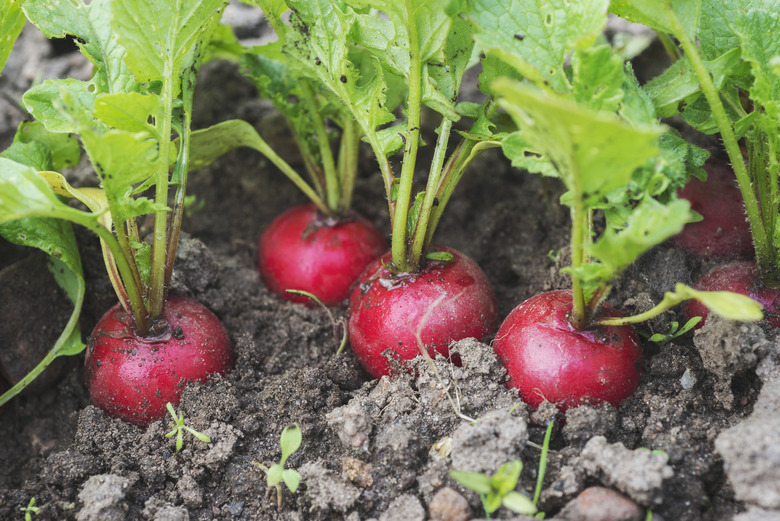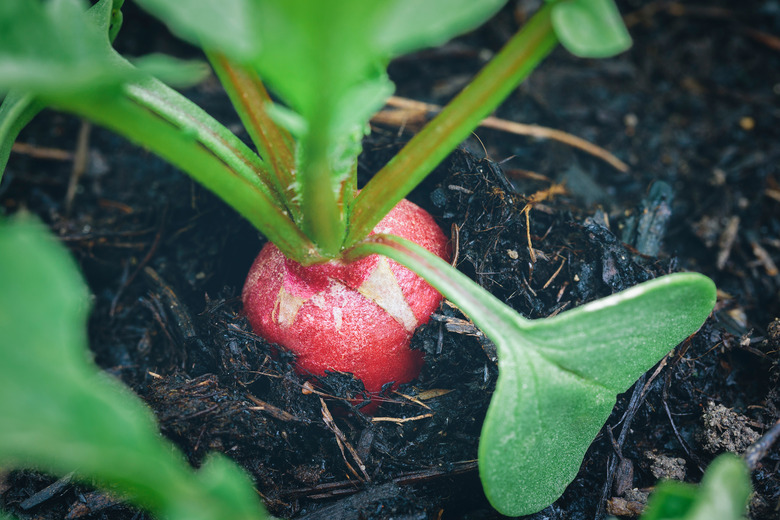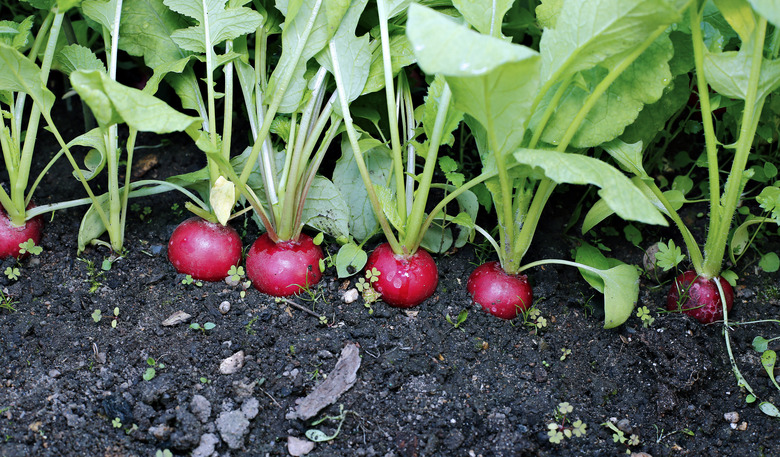How To Grow Radishes
We may receive a commission on purchases made from links.
If you're trying your hand at growing spring radishes (Raphanus raphanistrum subsp. sativus) for the first time, you may find them almost too easy to grow. Because they grow easily and mature quickly, many first-time radish growers end up with an overwhelmingly large crop. Grow too many, which is easy to do, and you'll find yourself foisting radishes onto everyone you know while frantically scouring recipe books for new and creative ways to eat them.
To avoid this, plant radishes sparingly until you're familiar with cultivating them. You can even plant a radish here and there among your other garden plants rather than devoting an entire section of your garden to them. Give them lots of sun and the right amount of water and they'll quickly reward you with perfectly spicy vegetables.
Where Do Radishes Grow Best?
Where Do Radishes Grow Best?
Radishes are an annual vegetable, and they grow readily in USDA hardiness zones 2 through 10. You can grow them anywhere in the United States as long as the soil temperature is correct when you do so (anywhere between 55 and 70 degrees Fahrenheit). Can't tell if your soil is the right temperature? Purchase a soil thermometer for a few dollars at the garden center and take a reading every so often a few days before you decide to plant.
When Should You Plant Radishes?
When Should You Plant Radishes?
Radishes are a cold-weather crop, and planting times may vary from one region to another. Gardeners in the North should sow their radishes in early spring and late fall for best results. Those in warmer regions may find that radishes grow better over the winter.
No matter where you live, radishes do best when soil temperatures are between 55 and 70 degrees. You can adjust planting times as needed to accommodate this.
Preparing the Garden Bed
Preparing the Garden Bed
Radishes need loose earth to grow properly, so work your soil with a tiller to a depth of 12 inches deep before planting. Make sure your soil is rich in potassium and phosphorous. Because they grow so quickly, it's best to work fertilizer into your soil before planting radishes. Choose a fertilizer low in nitrogen but high in potassium and phosphorous – too much nitrogen will cause your radishes to grow more leaves rather than roots, and too little phosphorus can negatively impact the taste of your crop.
Plant your radishes in full sun, giving then a loamy, sandy soil with a pH between 5.5 and 6.8. If you have heavy clay soil, work in some organic matter, such as compost or coir, in addition to the fertilizer. If you are growing spring radishes in a container, make sure the soil is at least 6 inches deep.
Starting Radishes From Seed
Starting Radishes From Seed
Like green beans and other veggies with tender roots, radish seeds are best sown directly in the garden rather than started indoors. Seeds are divided into either spring or winter varieties, and each is planted at a different time. Sow your radish seeds about 1/2 inch deep and space them 4 inches apart. Cover with soil and gently water the garden bed.
Spring radishes are generally planted as soon as you can work the ground in the spring. This is usually about two to three weeks before the last expected frost. Plant winter radishes in the fall, four to six weeks before the first frost. Radishes germinate best in soil temperatures between 55 and 70 degrees Fahrenheit, so skip summer planting.
Radishes planted in summer heat typically bolt (go to seed) and fail to produce. They're often bitter, too. If you live in a warm region, you may have to plant your radishes in the winter. Soil temperature is more important than the specific timing.
Much like moody teenagers, radishes need their space. Radishes that grow too close together won't plump up, leading to a disappointing harvest. If you want small radishes for salads, thin your radish seedlings to 2 inches apart when they emerge and for bigger radish varieties, thin your plants to 4 inches apart. You can also plant them using seed tape to space them properly and eliminate the need for thinning.
Caring for Radishes
Caring for Radishes
Radishes are easy to grow, but they can get a little finicky about their water. Those that receive too little water go to seed too quickly and develop a pungent taste. They also have an unpleasant, pithy texture.
Those that get too much water, however, will split or rot. Like Goldilocks, they like things just right. For radishes, this means constant, even soil moisture throughout the growing season. Water only as needed to achieve this.
Mulching around your radishes will help retain moisture. If you add a little wood ash to your mulch, you can help prevent root maggots. Don't do so, however, if your soil pH is already 6.7 or higher, as wood ash can raise your soil's pH level. Water your radishes before they dry out, keeping the soil around them evenly moist but not soggy.
It's always a good idea to remove weeds from your garden promptly so they don't shade other plants or compete with them for soil nutrients. Radishes are particularly susceptible and can find themselves crowded or shaded by weeds quickly. Even with mulch, check for weeds regularly and remove them promptly.
Winterizing Your Radishes
Winterizing Your Radishes
Gardeners in the South often grow radishes outdoors during mild winters. Those in cooler climates can do the same, but it takes a bit more work. One method is to plant your radishes in a container. Place the container in a sheltered spot and if the temperature is expected to dip below freezing, bring your radishes into a garage or basement for the night.
Another option is to grow your radishes under a cloche, which is any covering that sits above your plants and acts as a greenhouse for them. To make your own, cut the bottom half off a translucent plastic milk jug. Sow a few radish seeds together and place your milk jug on top of them with the cap off. On cold nights, put the cap back on your makeshift cloche to help hold the heat and on warm days, remove the cloche completely.
You can grow winter radishes this way, but you must clearly pay attention to the weather in order to do so successfully. Only your tastebuds can decide whether you love winter radishes enough to give this a try.
While these methods work with intermittent freezing, they won't work in places where the ground freezes at the beginning of the winter and stays frozen throughout the season. If you garden in one of these areas, you'll have to settle for store-bought radishes during the winter season.
How to Harvest Radishes
How to Harvest Radishes
Spring radishes go from seed to harvest in as little as three weeks, depending on the cultivar you're growing, while winter radishes are harvested seven to 10 weeks after planting. Radishes are ready to harvest when the top of the radish just beneath the soil is about 1 inch in diameter for spring radishes and 1 to 2 inches for winter radishes. To know for sure, pull a radish and taste it. If it's not quite ready with its signature spicy and tangy flavor, leave the others for a day or so.
You don't want to pick a radish before its time but don't dawdle either. Radishes harvested too late develop a spongey texture and overly strong taste. The window between radish perfection and a radish left in the ground too long is a very small one, so be diligent about harvest time.
When they're ready, harvesting your radishes is as simple as plucking the entire plant out of the ground. You can then cut away the leaves and bottom roots, storing the remaining radish in a plastic bag in the fridge. They'll last for several months there.
Using Radishes in the Kitchen
Using Radishes in the Kitchen
As they do with most vegetable crops, home gardeners grow radishes for food. The plants are not particularly decorative or exciting to behold, but they do produce a crisp, peppery root that enhances many culinary endeavors.
The trick with radishes is to think outside the box. They do make a wonderful addition to summer salads, but they can do much more. You can add them to casseroles or soups for a little zip or pickle your radishes for a tasty snack. You can also roast, steam and sauté radishes.
Winter radishes can be sliced and used in stir fries, stews and other dishes or pickled. If picked young, slice and use fresh in salads like the smaller spring radishes.
Monitoring for Pests and Problems
Monitoring for Pests and Problems
Radishes are relatively pest-free, but flea beetles and root maggots can both cause problems. Flea beetles eat tiny holes in the leaves of plants and can also feed on the roots. Because they overwinter in the ground, rotating your radish plantings can prevent recurring issues.
Tilling your soil before you plant often kills any lurking flea beetles. Floating row covers will keep these pests at bay, as will a sprinkling of diatomaceous earth.
Root maggots can chew through your radishes and quickly decimate your crop, but they too have a simple solution. As is true of flea beetles, you can ward off root maggots by rotating your crops and applying some diatomaceous earth.
Preventing Radish Diseases
Preventing Radish Diseases
Because they grow so quickly, spring radishes are often harvested before diseases have time to take hold. Bacterial and fungal infections are rare but possible. To prevent them, rotate your crops, allow proper spacing for air circulation and avoid working in the garden when it's wet. As is almost always recommended, direct irrigation water toward the plant's roots rather than its leaves.
If you have an issue, you can treat the problem with a food-safe fungicide or antibacterial agent. However, radish growers rarely need to treat plant diseases in the home garden.


